Iran, plagued with poverty and drought
A brief review of destruction of human beings and environment over 4 decades of the clerical regime’s rule
Introduction
Thirty-eight years after the mullahs seized power in Iran, the economic forecast for ordinary Iranians looks dire. The middle-class in Iran has been all but extinguished. Save for a few affluent neighborhoods that house the extremely wealthy, the vast majority of the country’s 80-million population live well under the poverty line. Breadwinners for many households are forced to take up secondary and tertiary jobs to make ends meet. Almost all across Iran, notices are put up on city walls by people willing to sell a kidney for the equivalent of $2,000. Those who do have a job, such as miners and factory workers, often are forced to work for months without pay.
The grim state of poverty contrasts with the immense Iranian national wealth that is being poured by the authorities into Syria to prop up dictator Bashar al-Assad and into other Middle Eastern hotspots such as Iraq and Yemen as part of the regime’s drive to impose its hegemony on the region. Another cause of public anger is the huge percentage of the country’s wealth which is pocketed by the elite super-rich – the mullahs, Revolutionary Guards and their affiliates and relatives. “The government of the elite 4 percent” – this was a major charge levelled against Hassan Rouhani’s administration in the course of the sham Presidential election.
The severe poverty that most Iranians are forced to endure, alongside news of Iranian state-assistance to Assad, Hezbollah and the Houthi rebels in Yemen, and economic mismanagement and corruption by officials have brought society to a brimming point. Not a day goes by without a major protest or riot by those who demand their basic livelihoods. While the authorities attempt to control the upheavals through a balance of suppression and promises of ending the austerity, the economic fabric of the Iranian society seems to have been torn far beyond the point of any meaningful recovery. This volatile state of the Iranian society now acts as a serious deterrent for interested outside investors in the Iranian market.
This study attempts to outline the social ramifications of the catastrophic state of Iran’s economy and political repression. The lack of accurate figures has made this task very difficult. The regime’s lack of transparency and censorship of information obstructs comprehensive research.
The only figures at hand are those made public by the national Statistics Center and the regime’s officials, which are mostly limited to percentages and comparisons with previous years. Nonetheless, the study aims to present the available information in order to provide a clear picture of the rapidly deteriorating state of society in Iran.
Rampant Poverty
The economic situation in Iran worsened in recent years. No concrete roadmap or solution has been provided to improve the conditions of some 80 million Iranian citizens whose lives are plagued with poverty and unemployment.
The economic crisis has not only affected the lower income sectors of the population but it has also destroyed Iran’s middle class which has formed the bedrock of Iranian society for centuries.
Officials offer a wide spectrum of varying figures. Nevertheless, these figures with any margin of error, bespeak of the disastrous state of the economy and the harsh living conditions for the majority of the Iranian populace.
According to a 2017 report by the Ministry of Roads and Urban Development cited by the Iranian Chamber of Commerce, 33% of Iran’s population (26.4 million) live below the poverty line.[1] However, the true figure of people living under the poverty line is said to be much higher. Some estimate it at 70% of the population.
Rostam Ghassemi, Iran’s former Oil Minister, said in March 2017, “We have 20 million poor people in the country.” [2] He added, “The country has become a powder keg, especially regarding the issue of unemployment.”
Parviz Fattah, head of the so-called Khomeini Relief Committee, said in a television interview that, “There are about 10 to 12 million people who right now are living under the absolute poverty.”[3]
In an interview on July 6, 2017, Mohammed Mokhber, director of the Headquarters for Implementation of the Order of Imam, said: “The situation in Iran has reached a dangerous level, where we have 12 million people living below the absolute poverty line and 30 million citizens living below the relative poverty line.”[4]
This means that the 12 million below the absolute poverty line cannot provide themselves with even the most basic needs like healthcare, food, housing, and education. These people are often malnourished and suffering from hunger.
Mokhber said, “The upward spiral of poverty in Iran has increased unexpectedly in the past seven years, foreshadowing social and security-related disasters in the near future.” He lamented that while Iran is the world’s fourth-largest source of valuable metals and occupies the tenth place globally in freshwater reserves, “its people live in the same (poverty-stricken) state as Burkina Faso.”
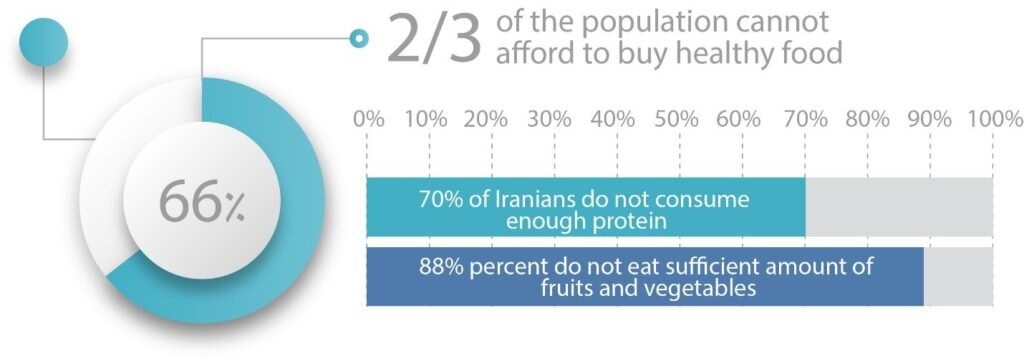
In 2016, Ali Akbar Sayyari, the health deputy for the Minister of Health, said, “More than 30% of the populace are hungry; this has been confirmed by the Ministry of Welfare,” he pointed out.[1] Sayyari also noted that some 10.2 million people have been identified as living on the edges of cities across the country.
An Iranian economist, Ibrahim Razzaghi, said 12 million Iranians are unemployed and 30 million are poor. He estimated that 80% of Iranian wage earners live below the poverty line and between 6 to 7 million people have trouble paying their rents.[2]
In a 2015 report, a political economist and family economy expert, Hossein Raghfar, said 40% of the total population of Iran (32 million) live under the absolute poverty line.[3]
An official housing expert said more than 33% of Iran’s population are not able to provide the minimum housing for their families.[4]
An official housing expert said more than 33% of Iran’s population are not able to provide the minimum, housing for their families.
A member of the parliamentary Social Committee believes that 70 to 80 percent of the people in Tehran live under the poverty line.[5]
Rampant poverty and the unfair distribution of wealth which has increased the gap between the rich and the poor has nearly destroyed the middle class, pushing low-income segments of the population who do not afford city life, to take up refuge in the outskirts of cities.
The phenomenon has become so widespread that Rouhani’s Minister of Roads and Urban Development, Abbas Akhundi, announced that “nearly 18 million of Iran’s population are living in marginal areas.”[1]

A worker or teacher who does not receive its salary on normal basis for months cannot provide the family’s monthly rent, thus many end up sleeping on cardboard boxes on the streets, a phenomenon that has become widespread.
After drug addiction, panhandlers, beggars and street children, people living out of cardboard boxes on city streets constitute the capital’s fourth major dilemma.
In winter 2016, a new phenomenon hit the headlines, the shocking problem of “grave dwellers.”
The world was appalled, as mainstream media reported about dozens of women, men and children who spent the nights sitting in open graves to escape cold winter.
The Iranian Deputy Health Minister Mohammad Hadi Ayazi acknowledged the vast scope of this problem, stating that 7,500 “grave sleepers” had been rounded up in a single day by security forces.[1]
Widespread and deep seated poverty has led to numerous social problems and abnormal ways for earning a living. There are no accurate statistics on these issues but they are so widespread that everyone, particularly the press, is talking about them. These problems have been outlined as the following:
Organ trade
Selling one’s own body organs or blood “on the black market” is a common practice and has actually turned into a business for some.
In recent years, many people who do not have any source of income to be able to provide for their children have turned to sell their body organs as a method of temporary relief. People openly post ads on the walls in streets adjacent to hospitals to offer their kidneys, liver, blood, cornea, bone marrow, etc. for sale.
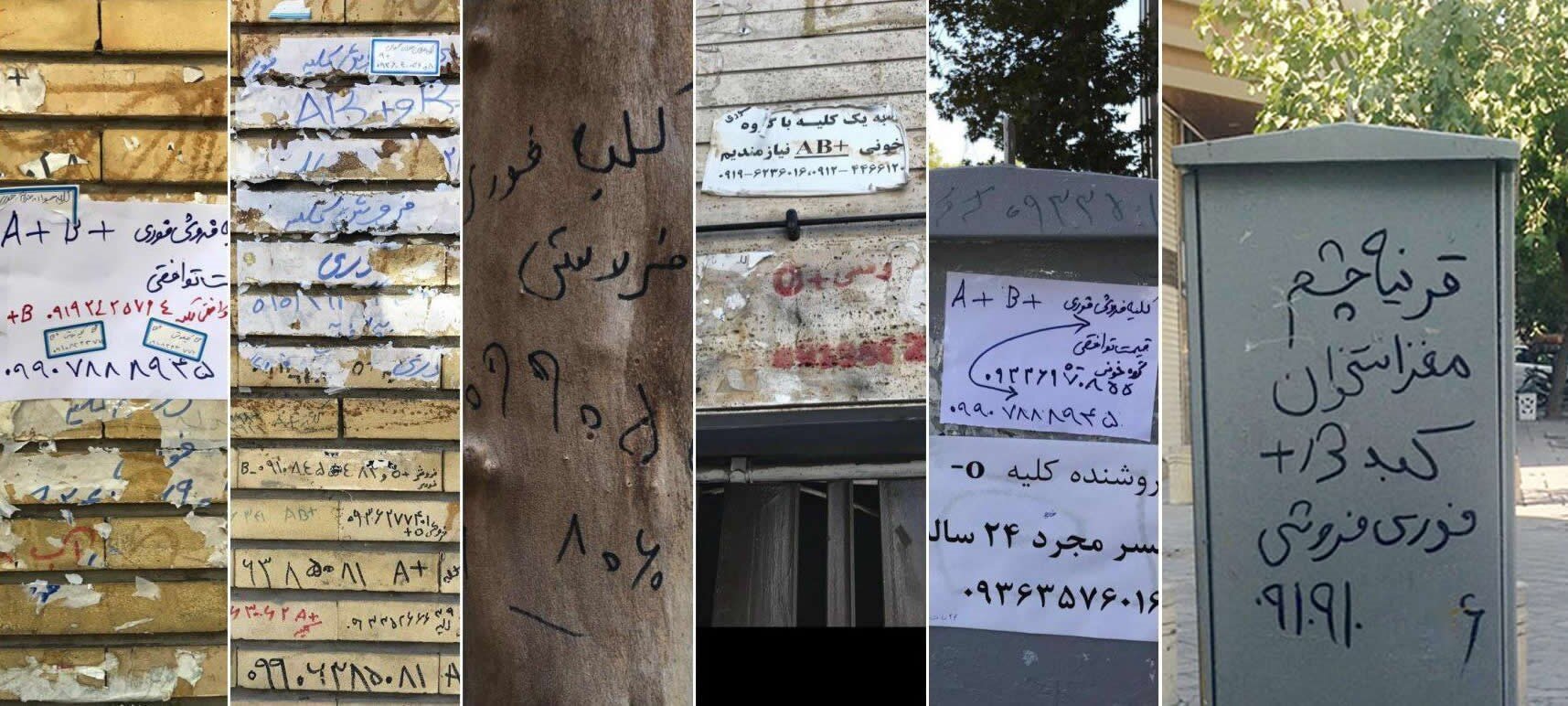
Posters and handwritten ads on city walls and public places offering kidney, cornea, bone marrow for sale.
|
“Seventy percent of all kidney transplants in Iran are from living individuals, whereas in other countries across the globe this rate is only 15%,” admitted Mohammad Reza Ganji, head of the Iranian regime’s Nephrology Association.[1]
A few years ago people started selling their cornea and bone marrow, as well.
“While selling blood, kidneys and livers is now common in Iran, currently this market is witnessing a growing trend of human eyes being offered for sale.”[2]
A few years ago people started selling their cornea and bone marrow, as well.
“While selling blood, kidneys and livers is now common in Iran, currently this market is witnessing a growing trend of human eyes being offered for sale.”[2]
In Iran, unlike any other country in the world, it is legal to sell organs and there are even dozens of organ supply units spread across the country. Recently, some people have set up their business by creating websites for exchange of body organs between sellers and buyers.
Alarmingly, mafia gangs are now trying to profit from the poverty present throughout the country.[3] They are apparently buying and selling children, and in most cases, cashing in on the children’s organs.
A member of Tehran City Council, Fatemeh Daneshvar on Saturday, July 1, 2017, referred to the gangs that sell and buy children in Tehran, stating that, “The children disappear in most cases and their organs are smuggled. After some time, their bodies are abandoned in the deserts without kidney and eyes.”[4]

An online center facilitating organ trade, including kidneys, uteruses and livers.
Sale of infants and children
One of the other tragic consequences of ubiquitous poverty in Iran is sale of unborn fetus and even older children. Homeless women usually have to sell their children due to extreme poverty. Posters offering “newborn baby for sale” or “children for sale” have become common place.
The children sold in this way are used for a variety of purposes including begging and drug trafficking, or are mutilated and their body parts sold.[1]
This phenomenon is of such a scale that even the state-run media cannot turn a blind eye on it.
The Noavaran daily newspaper wrote, “Amid the country’s economic and social disorder; among strange, uncomfortable ads selling kidneys and other organs seen at street corners, hospitals, and clinics, a new, more exotic ad has emerged in recent years and that is sale of fetuses in the womb.”
Tehran City Council’s Fatemeh Daneshvar said, “Homeless women come to hospitals in the south and central districts of the capital and after giving birth, the new born is sold for 100 – 200,000 toumans ($27-53).[2]
A state-run news outlet[1] published a report last August featuring the case of a 40-year-old woman by the name of Shiva; a mother of six, who has been forced to poverty to sell her unborn infant and her 3-year-old twin daughters by the names of Baran (Rain) and Bahar (Spring) for 15m toumans (about $5000) due to poverty.
Shiva’s eldest child, a 15-year-old boy by the name of Shahin, goes to school along with his 14-year-old twin sisters, Diba and Donya, with the financial support of his grandmother who is a seamstress. Shiva and her husband beg on the streets to earn a living. Part of their expenses are paid by Shiva’s 62-year-old mother who is a seamstress.
A hand-written note in Tehran, stuck on a wall in Azari street reads: “A fetus to be born in twenty days to be sold due to lack of proper means and conditions to care for it. Urgent!”
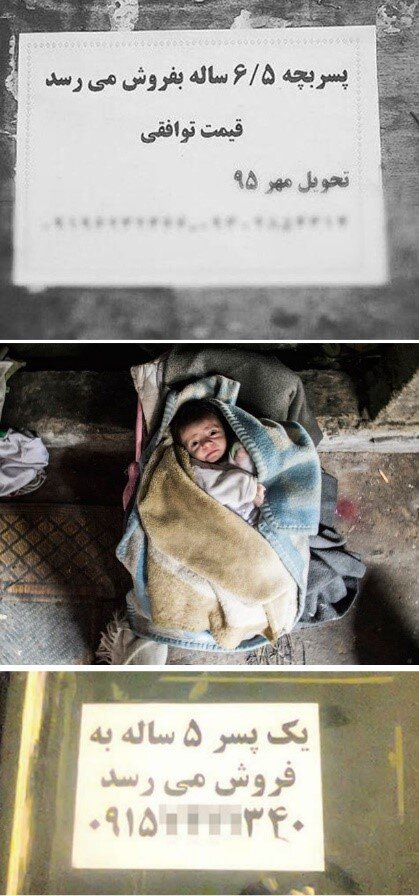
Some women do not find clients for their newborns and abandon them after birth.
Recently, a picture went viral on the internet, showing two newborn babies abandoned with no clothes or supplies in a hospital in Bandar Abbas.[1]
“Baby-sale” advertisements are also circulated on the internet, and can be found on banners on different websites.
One such banner read: “I am a 32-year-old woman and 4 months pregnant. Those who do not have children and want the custody of a child please let me know. They will get a baby. I am also a single woman with no source of income and I cannot raise a child.” There are reports where homeless women who sleep on cardboard boxes in the streets rent their children for 15,000 toumans ($5) a day as beggars. Or they sell them for 2 million toumans ($610).[2]
Again, Rouhani’s deputy for women’s affairs, Shahindokht Molaverdi has stated, “Today, we witness the sale of unborn infants in their mothers’ uterus and before they are born. We do not know the exact numbers but the numbers are large enough to make news.” [1]
Risking children’s lives to receive blood money
The social ramifications of poverty in Iran is not limited to sale of body parts, infants, children, etc. The Coroner’s Office of Khorassan Province, northeast Iran, announced that 1,011 people had hurt themselves, in fake accidents or even by sawing their own bones, in 2016.[1] The figure showed 14 per cent increase compared to the previous year.
The general director of Khorassan’s Coroner’s Office explained that people use anesthetic sprays or injections to be able to break their own bones in order to receive compensations (called Diyeh literally meaning blood money in the regime’s laws) from their insurance companies or other government agencies. In one case, a man had sawed his own shoulder bone.
In another incident, a father pushed his own son onto the street to get run over by a car in order to receive compensation for his injury.[2] Unfortunately, the child died in hospital due to internal hemorrhage. Traffic cameras[3] have also recorded people who deliberately throw themselves in front of the passing cars, in order to receive Diyeh for their injury.
Widespread drug addiction
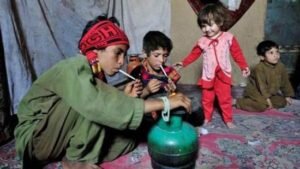
Today, addiction and use of drugs are widespread, particularly among children and students, in Iran. There is a direct correlation
between poverty, homelessness and addiction, as children living on the edge of the cities generally use drugs.
The number of people suffering from drug addiction has more than doubled since 2011, according to a survey by a drug control group.[1] The majority of Iran’s at least 14 million drug users drug users[2] are young men and women. The average age of addiction in Iran has dropped to 13, according to reports published by state media. [3] However, there are numerous reports of children as young as 3 and 4 who start using drugs along with their addicted parents, and an increasing number of infants who are born with drug addiction.
Disappointingly, the Iranian regime has no short or long-term plans to contain the unbridled spread of addiction especially among the young populace.
Experts argue that easy access to cheap narcotic drugs has contributed to the horrific number of drug addicts in Iran. It is common knowledge that narcotics can be purchased much easier than a loaf of bread.

Experts say, “increased marginalization has contributed to the spread of addiction among children and teenagers, as this section of society is highly vulnerable to social harms. It is noteworthy that poor family conditions are the reason for 90 percent of addiction cases among youths.”[1]
The head of the Association of Social Workers acknowledged that “teen students are more vulnerable than others to the risk of addiction. Drug dealers tend to target young students since they could be their source of income for years.”[2]
The commander of the Independent Committee on Combating Drugs, once told the Expediency Council, that no drug cartels had been seized since the regime took power in 1979. He said, “I venture to say that from the inception of the Islamic Republic, the drug cartels have not been hit even one percent. Some 1,100 billion toumans of people’s money is wasted on drugs every day.”[1]

The Director of the Education Department’s Social Harms Prevention Office, Nader Mansourkiaii, announced recently that 136,000 students are prone to drug use, with 3,600 of them having used drugs at least once.[2] Recently, there were reports that 130,000 school-age children in Iran were addicted to drugs, most of them between the ages of seven and 19. [3]
The Coroner’s Organization announced that in 2016 some 3,190 people died due to drug use and the drug related casualties have increased by 6.2% compared to the previous year.[1]
Prostitution
Another consequence of poverty in Iran for women is prostitution.
The average age of prostitution has dropped to 14 years. [1] Some experts put the number of prostitutes in Iran at 300 to 600 thousand.[2]
A senior expert in psychology, Farahnaz Salimi, had this to say about prostitution in Tehran: “There are women who have to sell their body to provide for only one meal. The average price for these sex workers is 60,000 toumans ($18). Sixty per cent of these women are addicted or have some precedence of addiction. 30 per cent of them are women whose husbands are in jail and 15 per cent have been in jail, themselves. 30 per cent of these prostitutes have high school diplomas or higher education. Many of these women who get pregnant either sell their infants, turn them in to welfare organizations or have abortions.”[3]
According to some reports, there are cases when women have to sell their bodies for only 5000 toumans ($1.5).[4] There are eyewitness reports on the social networks including the shocking case of a married woman who had not been able to buy meat to feed her sick child, while shivering offered her body to the butcher in exchange for some meat. A jobless woman who had to provide for her three children and had already sold one of her kidneys, had been left with no choice but to sell her body.[5]
There have also been reports of some girls having to sell their bodies to buy a pair of shoes or a manteaux.[6] A study[7] by the Women’s Committee of the National Council of Resistance of Iran shows that flagrant discrimination against women in education, employment and job opportunities, and other areas of social life contributes to the spread of prostitution in the country, as women are left with no decent options to earn a living to support their own and their children’s lives.
Human trafficking
Iran is among the countries failing to crack down on human trafficking. According to the 2017 report of the U.S. State Department on Trafficking in Persons (TiP), Iran is among the world’s worst offenders in human trafficking and forced labor.[1]
The annual TiP report which ranks countries in a three-tier system on their effectiveness in tackling human trafficking and other forms of slavery, said Iran “does not fully meet the minimum standards for the elimination of trafficking and is not making significant efforts to do so; therefore, Iran remained on Tier 3.”
“As reported over the past five years, Iran is a source, transit, and destination country for men, women, and children subjected to sex trafficking and forced labor,” the State Department’s annual report – 2017 wrote. The report highlights Iranian officials’ involvement in human trafficking. “The government did not report anti-trafficking law enforcement efforts and officials continued to be complicit in trafficking crimes.”

On the women who are victims of human trafficking in Iran, the TIP wrote, “Some Iranian women, who seek employment to support their families in Iran, are vulnerable to sex trafficking. Iranian girls between the ages of 13 and 17 are targeted by traffickers for sale abroad; younger girls may be forced into domestic service until their traffickers consider them old enough to be subjected to child sex trafficking. In 2016, there was a reported increase in young Iranian women in prostitution in Dubai; some of these women may be trafficking victims. From 2009-2015, the transport of girls from and through Iran en route to other Persian Gulf states for sexual exploitation reportedly increased. Iranian girls were subjected to sex trafficking in brothels in the IKR, especially Sulaimaniya; in some cases, this exploitation was facilitated by Iranian trafficking networks. In 2015, the media reported Kurdistan Regional Government officials were among the clients of these brothels. In Tehran, Tabriz, and Astara, the number of teenage girls exploited in sex trafficking reportedly continues to increase. “Temporary” or “short-term” marriages lasting from one hour to one week—for the purpose of commercial sexual exploitation—are reportedly increasing in Iran. Trafficking rings reportedly use Shiraz, Iran, as a transit point to bring ethnic Azeri girls from Azerbaijan to the UAE for commercial sexual exploitation. Street children in Iran are highly vulnerable to trafficking. Organized criminal groups kidnap or purchase and force Iranian and migrant children, especially Afghan refugee children, to work as beggars and street vendors in cities, including Tehran. These children, who may be as young as three years old, are coerced through physical and sexual abuse and drug addiction.”
There have also been remarks by Iranian officials indicating children and even babies being smuggled out of country for sale. Fatemeh Daneshvar, chair of the social committee of Tehran’s City Council, announced on March 8, 2017, that babies who are born premature from street women are smuggled to other countries to be sold. She said, “Most of these infants are taken abroad and we do not know whether they are sold to organs trafficking gangs, to families or to brothels.”
Daneshvar said, “This gang sells baby girls for a price higher than boys and sends the babies to unknown destinations.”[1] Other reports indicate that young women and girls are smuggled from Khorassan and Sistan-o Baluchistan provinces to work in brothels in Pakistan.
A research done by the Iranian Foundation to Prevent Social Harms indicates that most victims of human trafficking are run-away girls and child peddlers. The same report states that every month, 55 young Iranians girls between 16 and 25 years of age are bought by rich people in Karachi, Pakistan.[2]
Another report stated that 286 people including 54 Iranian girls were recruited in an international book fair in Tehran and trafficked to the UAE for sex slavery.[3] A pilot said that a daily average of 10 to 15 girls are flown from Iran to Dubai for prostitution. Most of these girls are from Abadan, Ahwaz, Zahedan, Tabriz and Kermanshah, but the largest numbers belong to Tehran and Mashhad.[4]
Suicides
In Spring 2016, an increasing trend of suicides committed in public caught the media’s attention. The first case was that of a 15-year-old girl from Tabriz who threw herself off the tenth floor of a building in Tabriz taking her own life.

Reports indicate that the suicide rate doubled in 2016 compared to 2015.[1] The most common age of suicide is between 15 and 24 years.[2] Every two hours and 18 minutes one person commits suicide in Iran.[3]
One of the main causes of suicide in Iran is poverty and depression. According to World Health Organization, the rate of suicide internationally was 16 in men and 4 in women per million in 2012. While in Iran there are 200 suicide cases per hundred thousand people.[4]
Sirwan Renas, an analyst from Iranian Kurdistan, who monitors suicide numbers, says suicide is more prevalent among women than in men in these areas; the number of suicides amongst men is rising primarily due to high unemployment and growing sense of despair.[5] According to the figures published by WHO, women are the main victims of this type of death in the world. Iran is the third country in the world, where the number of successful suicides among women have increased. In recent years, suicide has seen more escalation among teenagers, youths and women.[6]
Although there are no accurate figures available on the suicide of men and women in Iran, but in 2012 one of the Iranian authorities said 3,640 Iranians had committed suicide and ended their lives arbitrarily.[1] Adults are not the only ones affected by rising suicide rates. Children also experience unprecedented levels of pressure as the economic depression worsens.
In a recent interview with the state-run ILNA news agency, Kiyanush Hadi Shariati, an Iranian children’s rights expert, said that the rising rate of child suicide in Iran is “unprecedented and alarming,” indicating that this has become a deep-rooted and critical problem in the Iranian society.[2]
Shariati said a number of factors severely traumatize Iran’s children so much that they see suicide as an escape. Among the factors he cited were rising violence, poverty, and fear of forced marriage.
Environmental disaster
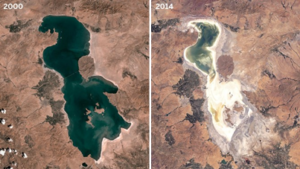
Human beings have not been the only victims of the mullahs’ regime. Iran’s natural resources have suffered as well. Dust storms and haze in southwestern Khuzistan Province, scarcity of water all across the country, drying up
of Lake Urmia in the northwestern province of West Azerbaijan, drying of Zayandeh Rood, in Isfahan, central Iran, as well as other rivers, alarming air pollution levels in Tehran and other cities, are some of the major environmental disasters in recent years.
Vast destruction of the nature in Iran deserves to be dealt with in a separate and comprehensive study, however, we only touch on some of the more conspicuous examples of the calamitous situation.
While part of the problem can be attributed to the global climate change, the regime must be blamed for adopting the wrong policies which have aggravated the conditions. Among them the policy of building a large number of dams on a single river for facilities run by the Islamic Revolutionary Guards Corps (IRGC) has been considered as the reason for drying of Lake Urmia, Zayandeh Rood and other major rivers in Khuzistan as well as the Kohgilouyeh and Boyer Ahmad provinces.
A former Agricultural Minister turned head of the Environment Protection Agency, Eassa Kalantari, once reiterated, “No enemy would’ve done what we did to our natural resources and the environment, were they ruling Iran during these years.”
He has acknowledged, “Major blows have been dealt to the country’s environment and natural resources over the past decades, so that Iran is now among the countries with the highest rate of soil erosion, exploitation of water resources, desertification, and so forth. Today, there’s not a single living wetland or lake in the country.” (State-run ISNA news agency, October 15, 2017)
The head of Meteorological Organization’s National Center for Drought and Crisis Management acknowledges that nearly 95 percent of the country is suffering from drought.[1]
The southern province of Kerman which produces one of the country’s main exports, pistachios, suffers from a “Drought Tsunami” [2] and 800 villages are supplied by water tanks. [3]
Final word
The Iranian regime’s huge expenditures on wars in other countries including Syria, Iraq, Yemen, Lebanon, etc. are common knowledge. This is where the lion’s share of the country’s revenues and wealth are spent instead of paying for salaries and investment in creation of jobs.
At the same time, the country’s officials are involved in embezzlement,[1] distribution of drugs and human trafficking, contributing to rampant social ailments.
One of the major areas controlled by the Islamic Revolutionary Guard Corps (IRGC)[2] that dominates the country’s political structure and economy, is the drug black market. The sale of narcotic drugs in Iran has been estimated by the Interior Minister at $3 billion per year[3] and people can have access to drugs for prices cheaper than bread.
In March 2012, the United States Department of Treasury labeled IRGC General Gholamreza Baghban a drug “kingpin.”[4] Other sources have reported of IRGC’s central role[5] in distribution of drugs in Iran and the world.[6]
As documented by the US State Department report in 2017, officials are also complicit in human trafficking.[7]
As the country is economically bankrupt and plagued with multiple crises and the society is in a volatile state, the ruling regime has no solutions to offer. The mullahs have so far kept the country in check by massive repression,[8] essentially under the guise of enforcing the mandatory dress code, and by an alarming rate of executions.[9]
No comments:
Post a Comment